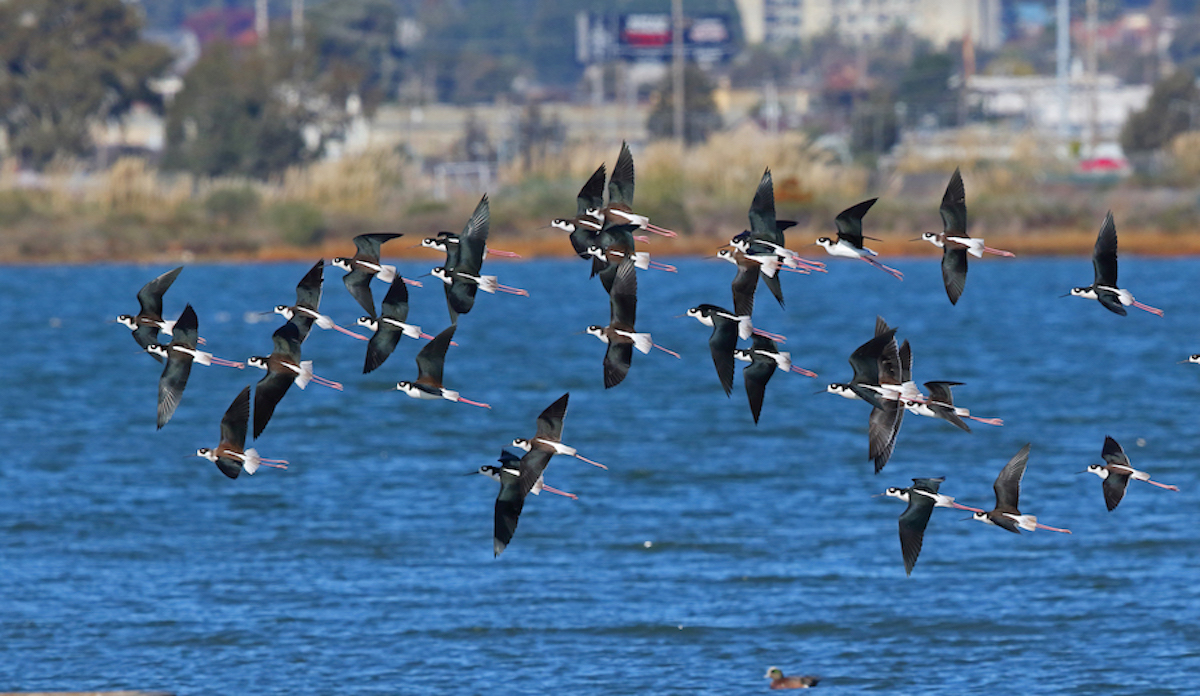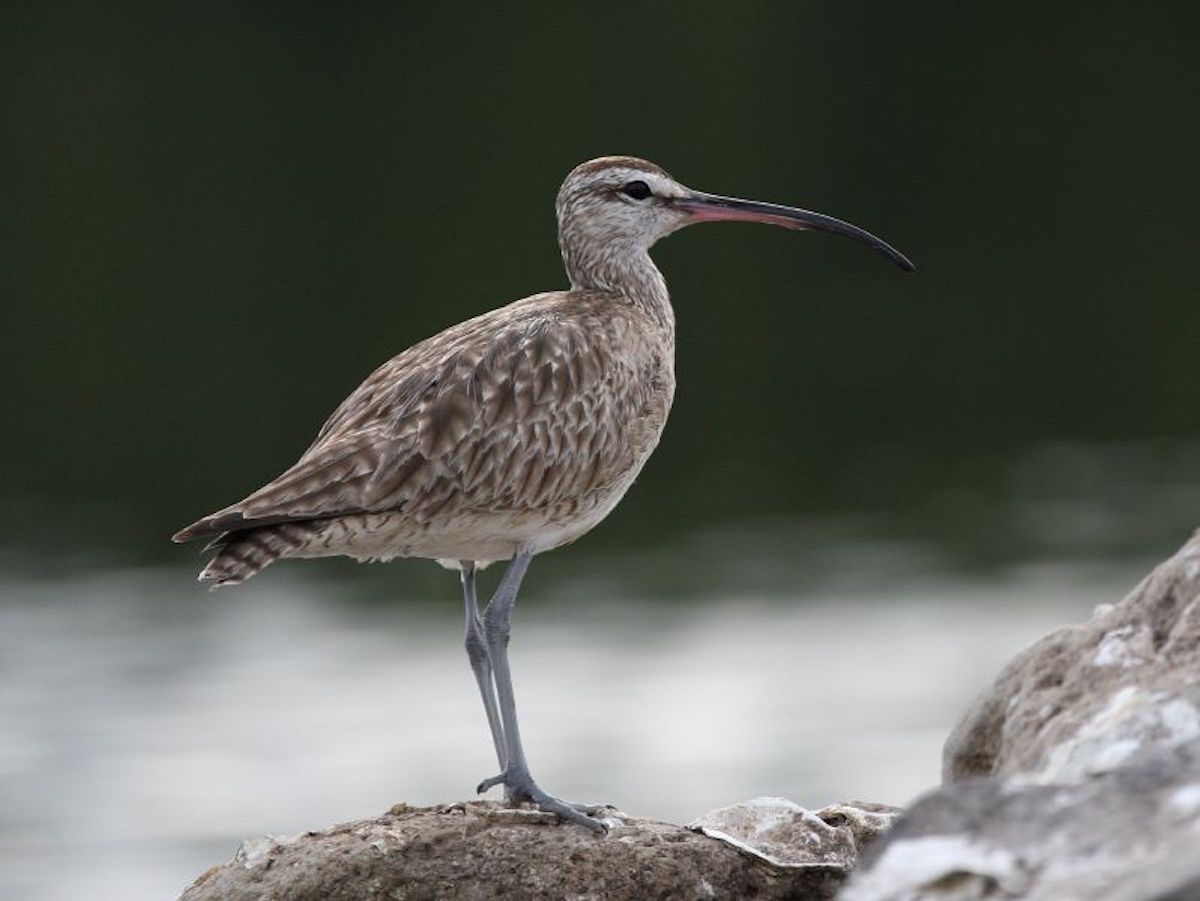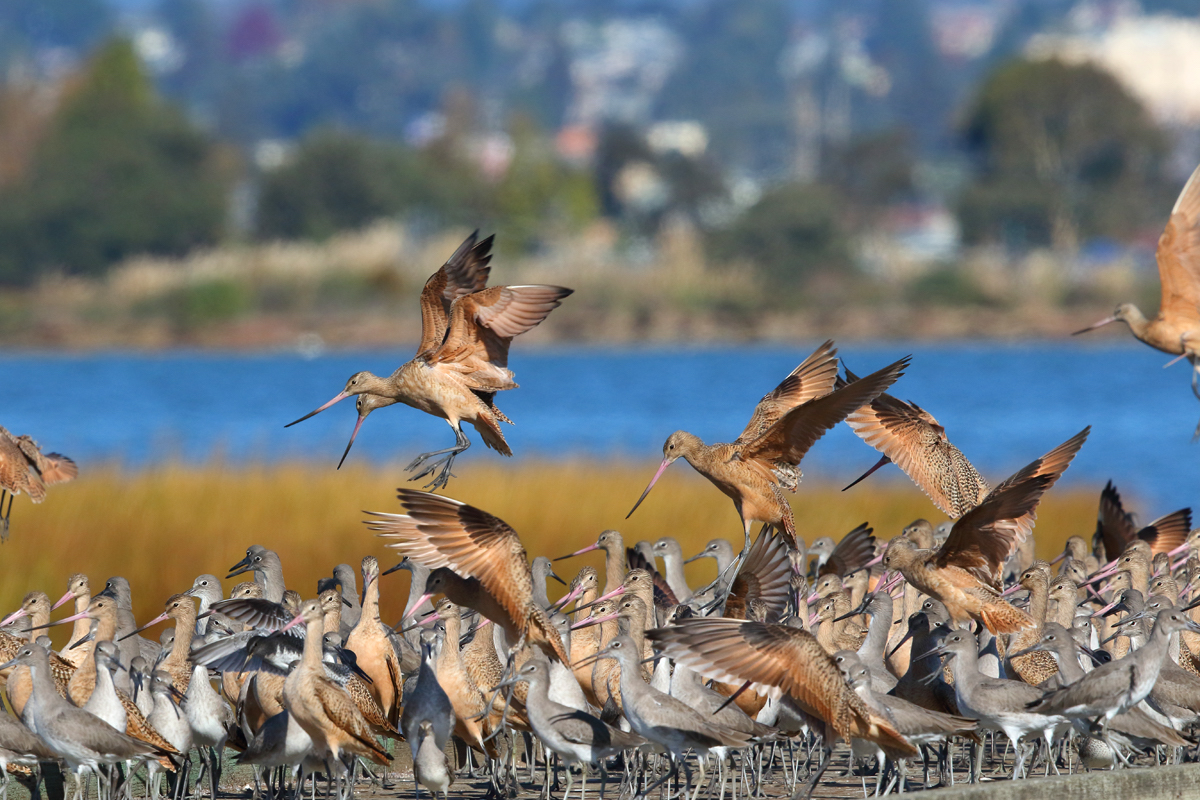Spring is almost here, but there’s still time to enjoy the thousands of shorebirds visiting the East Bay waterfront for some winter R&R.
Oakland has two superb sites for viewing shorebirds—Martin Luther King Jr. Regional Shoreline, near the airport, and Middle Harbor Shoreline Park, in the middle of the Port of Oakland.
These birds were able to travel in 2020, even if we couldn’t. Many flew thousands of miles to get here, from as far away as the High Arctic or the Great Plains. Shorebirds are drawn to the Bay Area in winter by our climate, our shorelines bordered with marsh plants, and the large variety of invertebrates and small shellfish that thrive in the Bay’s mix of salt and fresh water.

What is a shorebird?
Not all birds along the Oakland shoreline are shorebirds. The essential characteristic of shorebirds is that they feed by picking and probing with their bills. Some hunt by sight, while others with longer bills probe in the mud and the bay floor, hunting by touch and smell.
When you see a number of shorebirds feeding together, notice how their different sizes and bill lengths allow them to occupy slightly different niches in the same habitat, so that they’re not directly competing for the same food resources.
Shorebirds (the Brits call them “waders”) are also notable for their long legs:

Some great birds to get you started
Shorebird watching is rewarding for beginning birders and children, as many species are easy to see when wading and feeding along the shoreline. It’s helpful to have binoculars, but you can often get good looks with the naked eye.
Here are some of our larger shorebirds, which are easier for beginners to identify than the numerous tiny “peeps” or sandpipers that you’ll also see:
Long-billed Curlew: The largest North American shorebird is famous for its very long, down-curved bill. Its back and side feathers are a mix of warm peachy tones, along with brown and white. The combination of long legs and bill allow the Long-billed Curlew to reach food no other shorebird can get.
Its smaller cousin, the Whimbrel, is a study in shades of brown and white, with distinct head stripes. The Whimbrel also has a down-curved bill, but it’s relatively shorter and less sharply curved. In most Bay Area locations, Whimbrels are less common than Long-billed Curlews.


Marbled Godwit: This bird has a distinctly two-toned bill. The basal half nearer its head is pink, and the lower part is black. The Marbled Godwit’s overall coloration is also a warm peach. But its bill color and shape (almost straight, with a slight upturn) distinguish it from the Long-billed Curlew, and it’s also slightly smaller than a curlew.

Willet: In the winter, Willets are a study in gray—gray head and back, gray folded wings, and gray legs with a long, darker bill. When they fly, Willets display a broad white stripe on their wings. They’re smaller than Marbled Godwits, with whom they often feed and hang out.



Black-bellied Plover: Plovers are stocky, with short necks. Black-bellied Plovers have large black eyes, stubby black bills, and black legs. This bird is called the Grey Plover in the rest of the world, and when you see Black-bellied Plovers in the winter, you can understand why. Black-bellied Plovers do have black bellies, flanks, throats, necks, and faces—but only in their summer breeding plumage. If you see them in September, many still have some black belly feathers.

American Avocet: Some Avocets nest in the Bay Area, but there are many more here in the winter. Avocets have upturned bills. Distinctively patterned in black and white in the winter, both the females and males have rich cinnamon feathers on their necks and heads in spring and summer. Avocets swim as well as walk and wade. They feed in a variety of ways, but their most distinctive behavior is sweeping their bills side-to-side through the water in a motion called scything.


Black-necked Stilt: These tall, slender shorebirds have long bubble-gum pink legs and tuxedo-like coloring. Their necks are black and white; their faces are patterned in black and white; their backs and wings are black, and their bellies are white.

Other water birds: Although not classified as shorebirds, Great Blue Herons, Great Egrets, and Snowy Egrets are other spectacular birds that frequent the Oakland shoreline in winter, along with Brown Pelicans.
When and where to look for shorebirds
Shorebirds live by the tides. A web search with the keywords “NOAA Tide Predictions” and the names of the places listed below can give you a daily graph of high and low tides. On San Francisco Bay, there are two high tides and two low tides every day.
Many shorebirds will be actively feeding as the high tide goes out. When the tide chart shows a water level of 5 or 5.5 feet, there’s usually enough mudflat exposed for birds to forage but they’ll still be fairly close to shore—an ideal time for viewing.
The habitat available to shorebirds is just a fraction of what it once was: 90 percent of the Bay’s pre-1850 wetlands have been lost to development. Organizations like Save the Bay and Golden Gate Audubon Society are working hard to preserve what’s left and restore degraded shoreline so it’s welcoming to wildlife.

Oakland shorebird hotspots
Martin Luther King Jr. Regional Shoreline. Two of the entrances of this popular park are especially good for birdwatching. You’ll see plenty of ducks at this time of year, as well as shorebirds!
Swan Way entrance: Turn onto Swan Way from Doolittle Drive, and continue to the parking lot at the end of the road. Walk out onto the pier for views into the marsh. From the parking lot, take the path to the right for views from the fishing dock.
Edgewater Drive entrance: Turn onto Edgewater Drive from Hegenberger Road and continue to the Garretson Point parking lot at the end. Turn right onto the path to find shorebirds along the creek that enters the Bay.
Both these areas have restrooms. A map of the park can be found at ebparks.org under All Parks and Trails.

Middle Harbor Shoreline Park. This relatively unknown oasis is at the end of 7th Street, in the midst of the Port of Oakland. You’ll know you’re there when you see the flags on the mast of the U.S.S. Oakland. Walk out towards Arnold Point and along the shore towards the Chappell R. Hayes Observation Tower.
Want to go a little further afield? Elsie Roemer Bird Sanctuary in Alameda is small but filled with shorebirds during the winter. It’s at the southeast end of Crown Beach in Alameda. In Emeryville, look for shorebirds near the end of Powell Street, by the firehouse, and on the walking paths. In Albany, park at the foot of Buchanan Street to look for birds along the Albany Waterfront Trail. There’s also Hayward Regional Shoreline: From the Winton Avenue parking lot, walk north along the Bay Trail to a popular high tide roost colorfully known as Frank’s Dump.

More about shorebirds
Learn more about all these species at the Cornell Lab of Ornithology’s allaboutbirds.org website. Download their free Merlin app for your phone: It’s a really easy and user-friendly way to identify the birds you’re seeing.
Then get outside to the shoreline! Over the next month, many of our winter visitors will head off to their summer destinations, even if we are still sheltering in place. This is a great time to see them before they leave.
Maureen Lahiff teaches a shorebirds class for Golden Gate Audubon Society each winter and participates in local shorebird and waterbird counts. For more information on Oakland birds and birdwatching opportunities see goldengateaudubon.org.
